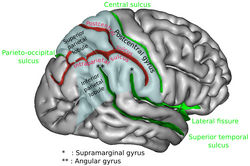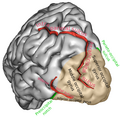Intraparietal sulcus
| Intraparietal sulcus | |
|---|---|
 Lateral surface of left cerebral hemisphere, viewed from the side. (Intraparietal sulcus visible at upper right, running horizontally.) | |
 Right cerebral hemisphere, viewed from the side. The region colored in blue is parietal lobe of the human brain. Intraparietal sulcus runs horizontally at the middle of the parietal lobe. | |
| Details | |
| Part of | Parietal lobe |
| Identifiers | |
| Latin | sulcus intraparietalis |
| Acronym(s) | IPS |
| NeuroNames | 97 |
| NeuroLex ID | birnlex_4031 |
| TA98 | A14.1.09.127 |
| TA2 | 5475 |
| FMA | 83772 |
| Anatomical terms of neuroanatomy | |
The intraparietal sulcus (IPS) is located on the lateral surface of the parietal lobe, and consists of an oblique and a horizontal portion. The IPS contains a series of functionally distinct subregions that have been intensively investigated using both single cell neurophysiology in primates[1][2] and human functional neuroimaging.[3] Its principal functions are related to perceptual-motor coordination (e.g., directing eye movements and reaching) and visual attention, which allows for visually-guided pointing, grasping, and object manipulation that can produce a desired effect.
The intraparietal sulcus (IPS) plays a pivotal role in multisensory integration, particularly in linking visual and tactile information to guide complex motor actions. Beyond its established roles in numerical cognition and spatial attention, the IPS has emerged as a critical player in tool use and manipulation.[4]
The IPS is also thought to play a role in other functions, including processing symbolic numerical information,[5] visuospatial working memory,[6] decision-making,[7] and interpreting the intent of others.[8][unreliable medical source?]
Function
[edit]Five regions of the intraparietal sulcus (IPS): anterior, lateral, ventral, caudal, and medial
- LIP & VIP: involved in visual attention and saccadic eye movements
- VIP & MIP: visual control of reaching and pointing
- AIP: visual control of grasping and manipulating hand movements
- CIP: perception of depth from stereopsis
All of these areas have projections to the frontal lobe for executive control.
Activity in the intraparietal sulcus has also been associated with the learning of sequences of finger movements.[9]
The dorsal attention network includes the intraparietal sulcus of each hemisphere.[10] The intraparietal sulcus is activated during voluntary orientation of attention.[11]
Understanding numbers
[edit]Behavioral studies suggest that the IPS is associated with impairments of basic numerical magnitude processing and that there is a pattern of structural and functional alternations in the IPS and in the PFC in dyscalculia.[12] Children with developmental dyscalculia were found to have less gray matter in the left IPS.[13]
Studies have shown that electrical activity in a particular group of nerve cells in the intraparietal sulcus spiked when, and only when, volunteers were performing calculations. Outside experimental settings it was also found that when a patient mentioned a number—or even a quantitative reference, such as "some more", "many" or "bigger than the other one"—there was a spike of electrical activity in the same nerve-cell population of the intraparietal sulcus that was activated when the patient was doing calculations under experimental conditions.[14]
Numerical magnitude processing refers to the cognitive ability to understand and compare numbers. This assists in tasks that involve estimation, mathematical processes, and decision-making. The intraparietal sulci are made up of two parts, left and right. The right intraparietal sulcus is involved more in non-symbolic numerical tasks, which involve estimation and spatial reasoning. The left intraparietal sulcus focuses on symbolic numerical tasks, which involves understanding symbols and mathematical operations. Studies have demonstrated that the right intraparietal sulcus shows more activity during magnitude estimation and length comparison tasks. Researchers discovered that disrupted activity in the right intraparietal lobe using rTMS, (repetitive transcranial magnetic stimulation) resulted in participants having difficulties with performance in both the magnitude and length tasks. Studies have shown that children who show a larger change in brain activity in the left intraparietal sulcus tend to perform better at arithmetic tasks. This suggests that the left intraparietal sulcus plays an important role when it comes to numerical processing and mathematics.[15][16]
Damage
[edit]Damage to the intraparietal sulcus (IPS) can make it difficult to represent and manipulate numerical quantities. Research completed by Ganor-Stern et al. investigated the involvement of the IPS in estimating the results of multi-digit multiplication problems.[17] In a computation estimation task, they compared a 24-year-old female (JD) with damage in the left IPS to an age-matched control group. During this estimation task, participants were presented with multi-digit multiplication problems accompanied by reference numbers. They were asked to estimate whether the exact answer to each problem was larger or smaller than the reference number. JD did not show the typical patterns of distance and size effects compared to control groups during this task. JD also had an atypical strategy in which she only used the approximated calculation strategy that involved rounding and calculating procedures. Most control participants used both a calculation strategy and the sense of magnitude strategy, which relies on an intuitive approximated magnitude representation of the results. The findings of this study suggest that damage to the IPS impaired JD’s representations of magnitude, which play an important role in everyday estimation tasks.
Additional images
[edit]-
Lateral surface of left cerebral hemisphere, viewed from above.
-
Left cerebral hemisphere, viewed from the back. (Intraparietal sulcus visible at top center)
-
Human brain dissection video (53 sec). Demonstrating position of the intraparietal sulcus of the left cerebral hemisphere.
References
[edit]- ^ Colby C.E.; Goldberg M.E. (1999). "Space and attention in parietal cortex". Annual Review of Neuroscience. 22: 319–349. doi:10.1146/annurev.neuro.22.1.319. PMID 10202542.
- ^ Andersen R.A. (1989). "Visual and eye movement functions of the posterior parietal cortex" (PDF). Annual Review of Neuroscience. 12: 377–403. doi:10.1146/annurev.ne.12.030189.002113. PMID 2648954.
- ^ Culham, J.C.; Nancy G. Kanwisher (April 2001). "Neuroimaging of cognitive functions in human parietal cortex". Current Opinion in Neurobiology. 11 (2): 157–163. doi:10.1016/S0959-4388(00)00191-4. PMID 11301234. S2CID 13907037.
- ^ Swisher, Jascha D.; Halko, Mark A.; Merabet, Lotfi B.; McMains, Stephanie A.; Somers, David C. (2007-05-16). "Visual Topography of Human Intraparietal Sulcus". Journal of Neuroscience. 27 (20): 5326–5337. doi:10.1523/JNEUROSCI.0991-07.2007. ISSN 0270-6474. PMID 17507555.
- ^ Cantlon J, Brannon E, Carter E, Pelphrey K (2006). "Functional imaging of numerical processing in adults and 4-y-old children". PLOS Biol. 4 (5): e125. doi:10.1371/journal.pbio.0040125. PMC 1431577. PMID 16594732.
- ^ Todd JJ, Marois R (2004). "Capacity limit of visual short-term memory in human posterior parietal cortex". Nature. 428 (6984): 751–754. Bibcode:2004Natur.428..751T. doi:10.1038/nature02466. PMID 15085133. S2CID 4415712.
- ^ Valdebenito-Oyarzo, Gabriela; Martínez-Molina, María Paz; Soto-Icaza, Patricia; Zamorano, Francisco; Figueroa-Vargas, Alejandra; Larraín-Valenzuela, Josefina; Stecher, Ximena; Salinas, César; Bastin, Julien; Valero-Cabré, Antoni; Polania, Rafael; Billeke, Pablo (10 January 2024). "The parietal cortex has a causal role in ambiguity computations in humans". PLOS Biology. 22 (1): e3002452. doi:10.1371/journal.pbio.3002452. PMC 10824459. PMID 38198502.
- ^ Grafton, Hamilton (2006). "Dartmouth Study Finds How The Brain Interprets The Intent Of Others". Science Daily.
- ^ Sakai, K.; Ramnani, N.; Passingham, R. E. (2002). "Learning of sequences of finger movements and timing: Frontal lobe and action-oriented representation". Journal of Neurophysiology. 88 (4): 2035–2046. doi:10.1152/jn.2002.88.4.2035. PMID 12364526.
- ^ Fox, M.D.; Corbetta, M.; Snyder, A.Z.; Vincent, J.L.; Raichle, M.E. (2006). "Spontaneous neuronal activity distinguishes human dorsal and ventral attention systems". Proceedings of the National Academy of Sciences. 103 (26): 10046–10051. Bibcode:2006PNAS..10310046F. doi:10.1073/pnas.0604187103. PMC 1480402. PMID 16788060.
- ^ Corbetta, M.; Kincade, J. M.; Ollinger, J. M.; McAvoy, M. P.; Shulman, G. L. (2000). "Voluntary orienting is dissociated from target detection in human posterior parietal cortex". Nature Neuroscience. 3 (3): 292–297. doi:10.1038/73009. PMID 10700263. S2CID 52807698.
- ^ Ansari D.; Karmiloff-Smith A. (2002). "Atypical trajectories of number development: a neuroconstructivist perspective". Trends in Cognitive Sciences. 6 (12): 511–516. doi:10.1016/S1364-6613(02)02040-5. PMID 12475711. S2CID 1228615.
- ^ Kucian K, et al. (2006). "Impaired neural networks for approximate calculation in dyscalculic children: a functional MRI study". Behavioral and Brain Functions. 2: 31. doi:10.1186/1744-9081-2-31. PMC 1574332. PMID 16953876.
- ^ Dastjerdi, M.; Ozker, M.; Foster, B. L.; Rangarajan, V.; Parvizi, J. (2013). "Numerical processing in the human parietal cortex during experimental and natural conditions". Nature Communications. 4: 2528. Bibcode:2013NatCo...4.2528D. doi:10.1038/ncomms3528. PMC 3826627. PMID 24129341.
- ^ Dormal, Valérie; Andres, Michael; Pesenti, Mauro (2012-05-01). "Contribution of the right intraparietal sulcus to numerosity and length processing: An fMRI-guided TMS study". Cortex. 48 (5): 623–629. doi:10.1016/j.cortex.2011.05.019. ISSN 0010-9452.
- ^ Bugden, Stephanie; Price, Gavin R.; McLean, D. Adam; Ansari, Daniel (2012-10-01). "The role of the left intraparietal sulcus in the relationship between symbolic number processing and children's arithmetic competence". Developmental Cognitive Neuroscience. 2 (4): 448–457. doi:10.1016/j.dcn.2012.04.001. ISSN 1878-9293. PMC 7005765.
- ^ Ganor-Stern, Dana; Gliksman, Yarden; Naparstek, Sharon; Ifergane, Gal; Henik, Avishai (2020-07-01). "Damage to the Intraparietal Sulcus Impairs Magnitude Representations of Results of Complex Arithmetic Problems". Neuroscience. 438: 137–144. doi:10.1016/j.neuroscience.2020.05.006. ISSN 0306-4522.
External links
[edit]


